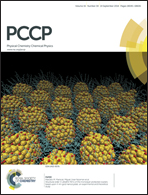Molecular dynamics simulation of the rupture mechanism in nanorod filled polymer nanocomposites†
Abstract
Through coarse-grained molecular dynamics simulation, we aim to uncover the rupture mechanism of polymer–nanorod nanocomposites by characterizing the structural and dynamic changes during the tension process. We find that the strain at failure is corresponding to the coalescence of a single void into larger voids, namely the change of the free volume. And the minimum of the Van der Walls (VDWL) energy reflects the maximum mobility of polymer chains and the largest number of voids of polymer nanocomposites. After the failure, the stress gradually decreases with the strain, accompanied by the contract of the highly orientated polymer bundles. In particular, we observe that the nucleation of voids prefers to occur from where the ends of polymer chains are located. We systematically study the effects of the interfacial interaction, temperature, the length and volume fraction of nanorods, chain length, bulk cross-linking density and interfacial chemical bonds on the rupture behavior, such as the stress at failure, the tensile modulus and the rupture energy. The rupture resistance ability increases with the increase of the interfacial interaction, rod length, and bulk cross-linking density. With an increase in the interfacial interaction, it induces the rupture transition from mode A (no bundles) to B (bundles). The transition point of the stress at failure as a function of the temperature roughly corresponds to the glass transition temperature. At longer chain length, a non-zero stress plateau occurs. And excessive chemical bonds between polymers and nanorods are harmful to the rupture property. We find that an optimal volume fraction of nanorods exists for the stress–strain behavior, which can be rationalized by the formation of the strongest polymer–nanorod network, leading to the slowest mobility of nanorods.


 Please wait while we load your content...
Please wait while we load your content...